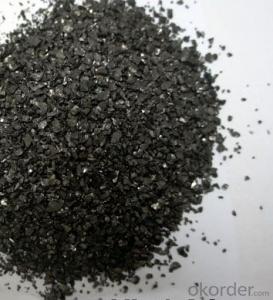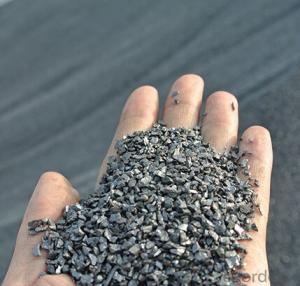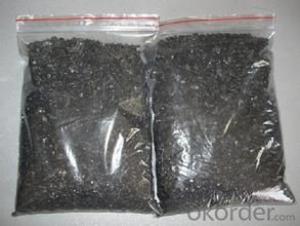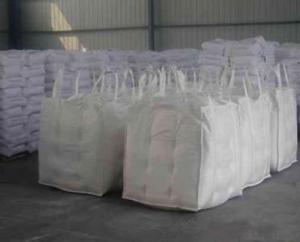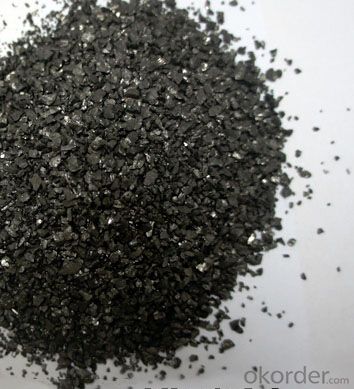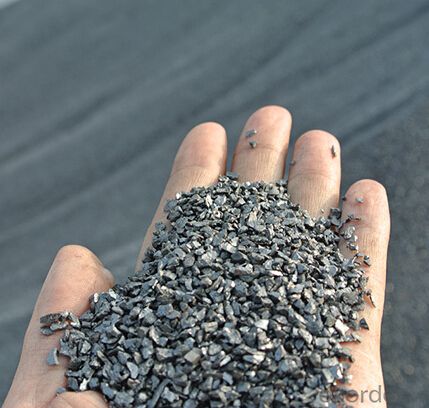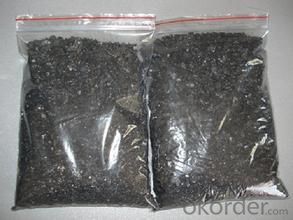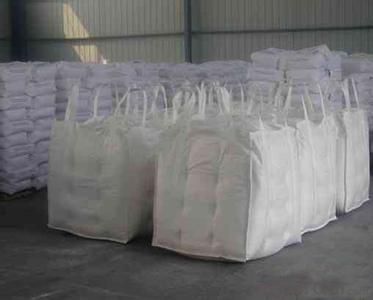Recarburizer 3-5mm 95% FC Carburant Carbon Additives
- Loading Port:
- Qingdao
- Payment Terms:
- TT OR LC
- Min Order Qty:
- 10 m.t.
- Supply Capability:
- 50000 m.t./month
OKorder Service Pledge
OKorder Financial Service
You Might Also Like
Specifications Of Recarburizer 95% FC
- High C content;
- Low S and N content;
- High abosorbility;
Recarburizer(Carburant, carbon additives) with high quality,0-20mm for metal casting foundry and steel plant, low nitrogen content and high carbon content, min 90% carbon content, at the same time as your requirements with no problem. The best media for adding carbon.
Technical Data Sheet of Recarburizer 95% FC
Fixed carbon | ≥ 95.5% |
Ash content | ≤ 5.0% |
Vol . Matter | ≤ 1.0% |
Sulphur content | ≤ 0.3% |
Moisture content | ≤ 0.3% |
Size | 0-20mm or as your requirement. |
Packing | - 25kg bag - One tone bags, Jumbo bag |
Delivery time | In 5-10 working days or depends on the order quantity |
Supply ability | 50000 Metric Ton Per Month |
Payment terms | L/C at sight or T/T |
Available Size: 0,1-4mm, 1-5mm, 3-8mm, 8-20mm (as per customers’ requirements)
Usage: widely used in casting foundry, steel-making, metallurgical Etc.
Applications of Recarburizer 95% FC
Mainly used in steel making in electrical stove, screening water, ship building sandblast to remove rust,producing carbon materials Etc.
Characteristics of Recarburizer 95% FC
- Particle size, porosity, absorption speed stable
- High degree of carbonize product, increase the original nuclear capability in the shape of liquid iron.
- Increased in the inoclation of nodular cast iron ball ink quantiyt, increase in th electric furnace iron graphit crystal nucleus.
- Excellent performance, stable.
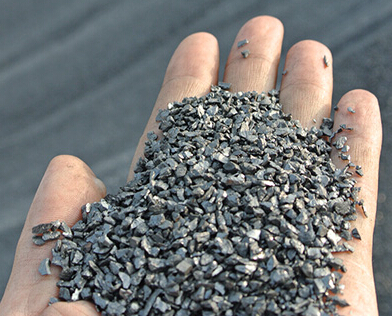
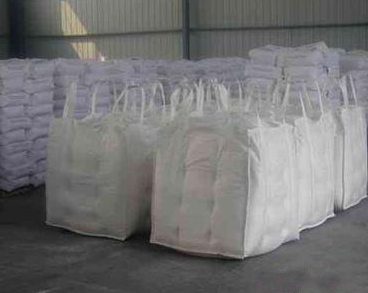
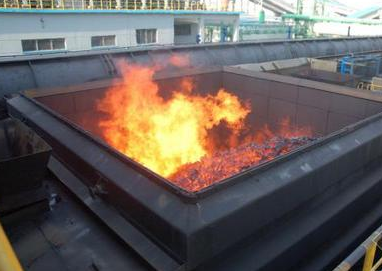
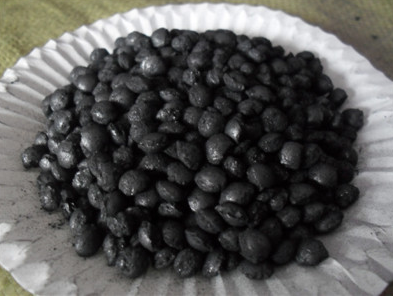
- Q: What is the carbon content of different types of household waste?
- The carbon content of various household waste types can differ based on the specific materials being disposed of. Generally, organic waste, including food scraps, yard waste, and paper products, tends to have higher carbon content when compared to inorganic waste like glass, plastics, and metals. Food waste consists mainly of organic materials and possesses a significant carbon content, typically ranging from 50 to 70 percent. This is because food originates from plants and animals, which contain carbon-rich carbohydrates, proteins, and fats. Yard waste, such as grass clippings, leaves, and branches, also contains a substantial amount of carbon. It is composed of plant matter predominantly made up of carbon-based compounds like cellulose and lignin. The carbon content of yard waste can vary depending on the vegetation type, but it generally falls between 40 to 60 percent. Paper products, such as newspapers, cardboard, and office paper, are primarily manufactured from wood pulp. Wood consists of carbon-containing compounds like cellulose, hemicellulose, and lignin. Consequently, paper waste possesses a notable carbon content, typically ranging from 40 to 60 percent. On the other hand, inorganic waste materials like glass, plastics, and metals have minimal carbon content. These materials are mainly derived from non-renewable resources such as minerals and fossil fuels, which have low carbon content. As a result, their carbon content is negligible or close to zero. It is crucial to acknowledge that while organic waste contains higher carbon content, it also holds the potential for composting or conversion into biogas through anaerobic digestion, thereby contributing to carbon sequestration or renewable energy generation. In contrast, inorganic waste materials like plastics and metals are non-biodegradable and can have harmful environmental consequences if not managed properly.
- Q: How does carbon impact the availability of sustainable agriculture practices?
- Carbon impacts the availability of sustainable agriculture practices by affecting climate change and soil health. Excessive release of carbon dioxide into the atmosphere contributes to global warming, altering weather patterns and making it harder for farmers to maintain consistent crop yields. Additionally, excessive carbon in the atmosphere leads to increased acidity in the oceans, affecting marine ecosystems and seafood availability. On the other hand, carbon sequestration through practices like agroforestry and regenerative agriculture helps mitigate climate change, improves soil fertility, and promotes sustainable farming methods. By reducing carbon emissions and adopting carbon sequestration techniques, sustainable agriculture practices can be more readily available and effective in ensuring long-term food security.
- Q: What are the different types of carbon-based drugs?
- There are several categories in which carbon-based drugs can be classified, based on their chemical structure and mode of action. One of the most common categories is alkaloids, which are naturally occurring compounds found in plants and have powerful pharmacological effects. Examples of carbon-based alkaloid drugs include morphine, codeine, and cocaine. Another category of carbon-based drugs is steroids. Steroids are compounds characterized by a carbon skeleton consisting of four fused rings. They are widely used in medicine because of their anti-inflammatory and immunosuppressive properties. Examples of carbon-based steroid drugs include cortisone, prednisone, and estrogen. Additionally, carbon-based drugs can be classified as nonsteroidal anti-inflammatory drugs (NSAIDs). These drugs work by inhibiting the action of cyclooxygenase enzymes, which reduces pain, inflammation, and fever. Common carbon-based NSAIDs include aspirin, ibuprofen, and naproxen. Furthermore, carbon-based drugs can be categorized as antibiotics. These are compounds derived from microorganisms or synthesized artificially that hinder the growth of bacteria or other microorganisms. Examples of carbon-based antibiotic drugs include penicillin, tetracycline, and erythromycin. Lastly, carbon-based drugs can also be synthetic compounds designed to target specific receptors or pathways in the body. These drugs are often created through extensive research and testing to treat various diseases and conditions. Examples of such drugs include cholesterol-lowering statins, antipsychotic medications, and anti-cancer drugs. To sum up, carbon-based drugs can be classified into alkaloids, steroids, NSAIDs, antibiotics, and synthetic compounds. Each category consists of drugs with diverse chemical structures and mechanisms of action, allowing for a wide range of therapeutic applications in the field of medicine.
- Q: What is carbon black filler?
- Carbon black filler is a type of additive that is commonly used in the production of rubber and plastic products. It is a fine, powdery substance that is derived from the incomplete combustion of hydrocarbons, such as oil or natural gas. Carbon black filler is composed primarily of elemental carbon, with small amounts of other elements such as hydrogen, oxygen, and sulfur. The main purpose of using carbon black filler is to improve the physical properties of rubber and plastic materials. It is added to enhance the strength, durability, and wear resistance of the final product. Carbon black filler also helps to increase the stiffness and hardness of the material, making it more suitable for various applications. In addition to its mechanical properties, carbon black filler also provides other benefits. It acts as a reinforcing agent, increasing the tensile strength and tear resistance of rubber compounds. It also enhances the electrical conductivity of the material, making it useful in applications where static electricity needs to be dissipated. Moreover, carbon black filler helps to protect the material from the harmful effects of UV radiation and ozone. It acts as a UV stabilizer and antioxidant, preventing degradation and prolonging the lifespan of the product. Carbon black filler also improves the thermal conductivity of rubber and plastic materials, aiding in heat dissipation. Overall, carbon black filler is a versatile and widely used additive in the manufacturing industry. Its unique properties make it an essential component in the production of a wide range of rubber and plastic products, including tires, conveyor belts, hoses, gaskets, and many more.
- Q: How does carbon affect the formation of volcanic eruptions?
- The formation of volcanic eruptions can be significantly influenced by carbon. One way in which carbon impacts volcanic eruptions is through the degassing process. When magma rises to the surface, it carries dissolved gases, including carbon dioxide. As the magma moves towards the surface and the pressure decreases, the dissolved gases begin to separate, forming gas bubbles within the magma. These gas bubbles can make the magma more buoyant, facilitating its ascent and eventually leading to an eruption. In addition, carbon can also affect the viscosity of magma, which measures its resistance to flow. Magma with higher carbon content tends to have lower viscosity, making it more fluid-like and capable of flowing more easily. This reduced viscosity enables the magma to move more swiftly towards the surface, increasing the chances of an eruption. Moreover, carbon can contribute to the explosiveness of volcanic eruptions. When magma reaches the surface, it can come into contact with organic matter, such as plant material or fossil fuels, which contain abundant carbon. This interaction can result in the combustion of the organic matter, releasing additional gases like methane. These gases can further elevate the pressure within the volcano, leading to more explosive eruptions. In summary, carbon plays a crucial role in the formation of volcanic eruptions. It influences the buoyancy and viscosity of magma and can contribute to the explosiveness of eruptions. Understanding the impact of carbon in volcanic processes is vital for predicting and mitigating the risks associated with volcanic activity.
- Q: What type of carbon copy sheet can be printed on? How many copies?
- Printed in carbon free carbon paper, usuallyUpper: whiteMedium: RedNext: yellowMainly depends on how much you want to print.
- Q: What is carbon offsetting in the hospitality industry?
- Carbon offsetting in the hospitality industry refers to the practice of counterbalancing the greenhouse gas emissions produced by hotels, resorts, and other hospitality businesses. It is a way to compensate for the carbon footprint created by various activities within the industry, such as energy consumption, transportation, waste management, and water usage. The process of carbon offsetting involves calculating the amount of carbon dioxide or other greenhouse gases emitted by a hospitality establishment and then investing in projects that reduce emissions elsewhere. These projects can include renewable energy initiatives, reforestation efforts, or energy efficiency programs. By supporting such projects, the hospitality industry aims to neutralize or offset its own carbon emissions, effectively reducing its impact on climate change. Hotels and resorts can choose to purchase carbon offsets from specialized organizations that facilitate carbon offset projects. These organizations ensure that the offsets are verified and comply with recognized standards, such as the Verified Carbon Standard or the Gold Standard. By investing in verified offsets, the hospitality industry can have confidence that their contributions are making a real and measurable difference in reducing global greenhouse gas emissions. Carbon offsetting in the hospitality industry is not only a way to demonstrate environmental responsibility, but it can also have economic benefits. Many travelers are becoming increasingly conscious of the environmental impact of their accommodation choices and are actively seeking out hotels and resorts that prioritize sustainability. By implementing carbon offsetting programs, hospitality businesses can attract environmentally conscious guests and differentiate themselves in a competitive market. Furthermore, carbon offsetting is just one part of a broader sustainability strategy within the hospitality industry. Many hotels and resorts are also adopting energy-efficient practices, implementing waste reduction measures, and promoting water conservation. By combining these efforts with carbon offsetting initiatives, the hospitality industry can contribute to a more sustainable future while also improving their bottom line. In summary, carbon offsetting in the hospitality industry involves investing in projects that reduce greenhouse gas emissions to compensate for the carbon footprint created by hotels and resorts. It is a way to neutralize the environmental impact of the industry and demonstrate a commitment to sustainability. By implementing carbon offsetting programs, the hospitality industry can attract environmentally conscious guests, differentiate themselves in the market, and contribute to a more sustainable future.
- Q: What are the meanings of carbon, graphite, burr, two cuts and four cuts in steel?.
- Flash is to flash, or two bending. Two cuts; one cut two on average, three segments, four cuts; an average cut of four, and five segments. The back is industry talk.
- Q: The main difference between steel and iron is the difference in carbon content
- Steel carbon content is 0.03% ~ 2% of the iron carbon alloy. Carbon steel is the most commonly used ordinary steel smelting, convenient, easy processing, low price, and can satisfy the use requirement in most cases, it is widely used. According to the different carbon content, carbon steel is divided into low carbon steel, medium carbon steel and high carbon steel with the carbon content increased, decreased the hardness, toughness of carbon steel alloy steel. Also called special steel, adding one or more alloying elements in steel on the basis of the change of microstructure and properties of steel, it has some special properties, such as high hardness, high wear resistance, high toughness and corrosion resistance sex, etc.
- Q: How does carbon impact the availability of clean energy solutions?
- Carbon has a significant impact on the availability of clean energy solutions. Carbon emissions from burning fossil fuels and other human activities are the main contributor to climate change, which poses a serious threat to the environment and human well-being. As a result, there is an urgent need to transition to cleaner energy sources that produce lower carbon emissions. Clean energy solutions, such as renewable energy technologies like solar and wind power, have the potential to reduce carbon emissions significantly. These sources of energy generate electricity without burning fossil fuels, thus producing little to no carbon emissions. By replacing traditional energy sources with clean ones, we can reduce our carbon footprint and mitigate climate change. However, the availability and scalability of clean energy solutions are impacted by carbon emissions in several ways. First, the continued reliance on carbon-intensive energy sources, such as coal and oil, hinders the rapid adoption of clean energy technologies. The infrastructure and investments in fossil fuel-based energy systems make it challenging to shift towards clean alternatives. Secondly, carbon emissions contribute to global warming, which affects the availability and efficiency of certain clean energy solutions. For example, rising temperatures can reduce the efficiency of solar panels and impact the output of hydropower due to changing rainfall patterns. This highlights the importance of mitigating carbon emissions to ensure the long-term viability and effectiveness of clean energy technologies. Furthermore, carbon emissions have economic implications that can impact the availability of clean energy solutions. Governments and policymakers play a crucial role in incentivizing the adoption of clean energy through regulations, subsidies, and carbon pricing mechanisms. These policies can influence the affordability and accessibility of clean energy technologies, making them more attractive to investors and consumers. In conclusion, carbon emissions have a profound impact on the availability of clean energy solutions. By reducing carbon emissions and transitioning to cleaner energy sources, we can mitigate climate change, improve the efficiency of clean energy technologies, and create a more sustainable future. It is essential for governments, businesses, and individuals to prioritize the development and adoption of clean energy solutions to ensure a cleaner and healthier planet for future generations.
Send your message to us
Recarburizer 3-5mm 95% FC Carburant Carbon Additives
- Loading Port:
- Qingdao
- Payment Terms:
- TT OR LC
- Min Order Qty:
- 10 m.t.
- Supply Capability:
- 50000 m.t./month
OKorder Service Pledge
OKorder Financial Service
Similar products
Hot products
Hot Searches
Related keywords
